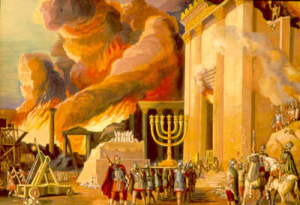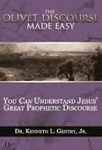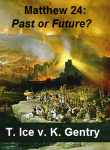THE SIGN OF THE SON OF MAN (1)
 PMT 2016-084 by Kenneth L. Gentry, Jr.
PMT 2016-084 by Kenneth L. Gentry, Jr.
Reader’s question
“Recently I preached on Matt 24:29 and following. In my message I made the point that the in vs. 30 Jesus was making two points. The first being that the destruction of the Temple would indicate to the world that He was now enthroned in heaven.
A Greek scholar in my congregation wrote a long email explaining why this is not what the passage means. He went as far as to say that the people I read and trust on this subject are wrong. I have taken Greek in seminary but I am in no place to argue with him.
Do you have a Greek study/explanation as to why verse 30 can be read with the meaning being that “then will appear the sign of the Son of Man in heaven?”
Gentry’s reply
I would note the following regarding this matter of the proper interpretation of Matt. 24:29–30:
First, we must understand that this is a much debated passage on all sides. It is not a held by a few, recent preterist “populists,” such as Gary DeMar and me. This interpretation cannot be easily written off.
Dispensationalist scholar David L. Turner (“Matthew” in Baker Exegetical Commentary on the New Testament, p. 581, 584) writes of Matt. 24:29–31: “Most scholars understand 24:15–28 to be speaking of events accompanying the destruction of Jerusalem in 70 CE…. There is a similar debate over the prevalent apocalyptic imagery in 24:29–31… Preterist scholars interpret this language as speaking of Jesus’s enthronement in heaven and/or the destruction of Jerusalem on earth.” Then he adds: “preterists … interpret 24:29–31 as symbolizing the theological significance of the temple’s destruction…. The coming of Jesus is viewed as his triumphal arrival in heaven after his resurrection (Dan. 7:13–14). Jesus’s exaltation results in Israel’s judgment, demonstrated by the destruction of the temple by the Romans in 70 CE.”
Prolific commentator Grant Osborne (“Matthew” in Exegetical Commentary on the New Testament, pp. 893–94) writes of Matt. 24:30: “What is the actual sign? Is it the cosmic portents of v. 29 (taking tou hiou tou anthropou as an objective genitive, a ‘sign pointing to the Son of Man,’ so Nolland) or the actual appearing of the Son of Man in this verse (taking it as an appositional genitive, ‘the sign that is the Son of Man’; so Bonnard, Gundry, Schnackenburg, Luz, Bruner)? Or is it separate from both (Hagner), perhaps the resurrection of the saints or the enthronement of Jesus in heaven (France)…? It is impossible to be certain.”
Olivet Discourse Made Easy (by Ken Gentry)
Verse-by-verse analysis of Christ’s teaching on Jerusalem’s destruction in Matt 24. Show the great tribulation is past, having occurred in AD 70.
See more study materials at: www.KennethGentry.com
Thus, Turner recognizes the widespread preterist understanding of this passage, even while he rejects it. And Osborne, who is well-known for his Greek exegetical prowess, deems the interpretation of the passage as uncertain, with the preterist analysis remaining as a live option.
This view has and is held by some noteworthy scholarly authorities, such as noted exegete and Hebrew scholars John Lightfoot (1602–75) and John Gill (1697-1771), as well as famed commentators Thomas Scott (1747–1821), Albert Barnes (1798–1870), and modern day noted commentators R. V. G. Tasker (1895–1976) and R. T. France (1938–2012) to name but a few.
These scholars know their Greek, and as usual, the Greek can be interpreted in different ways. They would hold that the highly symbolic-apocalyptic elements in the passage should not override the clearly literal references to the first century temple (Matt. 23:37–24:2), the local Jewish concerns (Matt. 24:15–16), and the limitation to the first century (Matt. 24:34).
Second, it is important to recognize that this understanding of Matt. 24:29–30 is not absolutely essential to the preterist argument in the overall passage (Matt. 24:1–34; the Discourse does not transition to the Second Advent until v. 36).
Actually it is theoretically possible that Matt. 24:29-30 could refer to the visible signs that Josephus mentions (and which are reported by Tacitus) in the era of the temple’s destruction.
Tasker (“Matthew” in Tyndale New Testament Commentary, p. 26) mentions these reported phenomena: “the voice which was heard, according to Tacitus, crying out ‘The gods are departing.’ The type of language used by the Roman historian in the passage from which this quotation is taken is certainly instructive. ‘Contending hosts were seen meeting in the skies, arms flashed, and suddenly the Temple was illumined with fire from the clouds. Of a sudden the doors of the shrine opened and a superhuman voice cried; ‘the gods are departing’: at the same moment the mighty stir of their going was heard.’
Matthew 24 Debate: Past or Future?
(DVD by Ken Gentry and Thomas Ice)
Two hour public debate between Ken Gentry and Thomas Ice on the Olivet Discourse.
See more study materials at: www.KennethGentry.com
Third, the Greek of the passage will allow for the understanding that the sign is “the Son of Man in heaven.” That is, that the judgments serve as a sign that the Son of Man is enthroned in heaven and is directing the AD 70 judgment.
The two questions that arise in this debate are: (1) How are we to translate ouranos: as “sky” or “heaven” (God’s abode)? (2) How are we to translate the genitive phrase following “the sign” which reads: tou huiou tou anthropou.
Several translations render ouranos as “heaven,” such as the ASV, ERV, ESV, NKJV, NRSV, and Young’s Literal translation. Neither option is necessarily wrong. So the option “heaven” is a possible rendering.
And as numerous scholars note, the genitival phrase “the Son of Man” can be either an objective genitive or an appositional genitive. If it is an objective genitive it would mean that a sign of some sort are pointers to the Son of Man. If it is an appositional genitive it would mean that the sign is the Son of Man himself, whether appearing in the sky or as being enthroned in heaven. Further citations from scholars in the next article will flesh this out.
Click on the following images for more information on these studies:











Kenneth L. Gentry Jr.'s Blog
- Kenneth L. Gentry Jr.'s profile
- 85 followers



